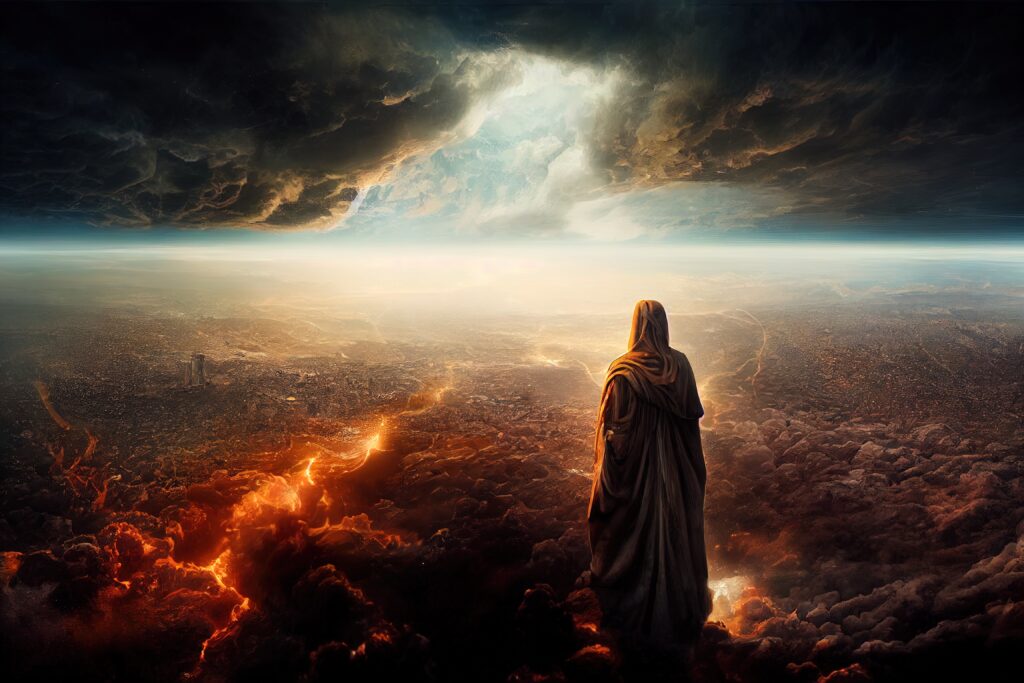
“KING OF KINGS, AND LORD OF LORDS.”
And I saw heaven opened, and behold, a white horse, and He who sat on it is called Faithful and True, and in righteousness He judges and wages war. His eyes are a flame of fire, and on His head are many crowns; and He has a name written on Him which no one knows except Himself. He is clothed with a robe dipped in blood, and His name is called The Word of God. And the armies which are in heaven, clothed in fine linen, white and clean, were following Him on white horses. From His mouth comes a sharp sword, so that with it He may strike down the nations, and He will rule them with a rod of iron; and He treads the wine press of the fierce wrath of God, the Almighty. And on His robe and on His thigh He has a name written: “KING OF KINGS, AND LORD OF LORDS.” Then I saw an angel standing in the sun, and he cried out with a loud voice, saying to all the birds that fly in midheaven, “Come, assemble for the great feast of God, so that you may eat the flesh of kings and the flesh of commanders, the flesh of mighty men, the flesh of horses and of those who sit on them, and the flesh of all people, both free and slaves, and small and great.” And I saw the beast and the kings of the earth and their armies, assembled to make war against Him who sat on the horse, and against His army. – Revelation 19:11-19. NASB
Remember the conceptual language we have discussed before. God speaks to us this way to help our understanding. Omipresence doesn’t sit on a chair (throne) or literally wear a crown, but the concept conveys the truth of rulership that God wants us to grasp. Riding the white horse is the same. Victors in battle did this in ancient times. The rider on a white horse is a symbolic depiction of Christ’s second coming, the fulfilment of the promise that believers of all ages have been longing for. Like Jesus, His people have based their faith on God’s Word. This is the culmination of Jesus’ many victories: Jesus defeated Satan in heaven; He defeated Satan in the wilderness; He defeated him at the cross, He defeated him at the tomb, and He will defeat him at His return.
Like in the days of Elijah after the Mt Carmel conflict, there appears in the east a small black cloud, about “half the size of a man’s hand” (1Kings 18:44). It is the cloud that surrounds Jesus and which seems in the distance to be shrouded in darkness. The people of God know this to be the sign of the Son of man. In solemn silence they gaze upon it as it draws nearer the earth, becoming lighter and more glorious until it is a great white cloud, its base appears as a glory like consuming fire, and above it the rainbow of the covenant. Jesus rides forth as a mighty conqueror. Not now a ‘Man of Sorrows’, to drink the bitter cup of shame and woe, He comes, victor in heaven and earth, to judge the living and the dead. ‘Faithful and True’, ‘in righteousness, he does judge and make war’. And ‘the armies which were in heaven’ (Rev.19:11-14) follow Him. With anthems of celestial melody, the holy angels, a vast, unnumbered throng, attend Him on His way. The firmament seems filled with radiant forms , “like lightening from the east” “That every eye shall see” He encircles the globe – 100 thousand million angels. No human pen can portray the scene; no mortal mind is adequate to conceive its splendour.
In 2THess.1:8-10, Paul gives another depiction of the ultimate victory of Christ at the Second Coming, when all the secular and religious powers, which had conspired against Him, are destroyed by the brightness of His coming, and His people are delivered for all eternity. PTL
Then comes the imagery of 2 suppers in this passage V:9 and V17&18. They represent a stark contrast of the stakes involved in the whole great controversy. TBC
